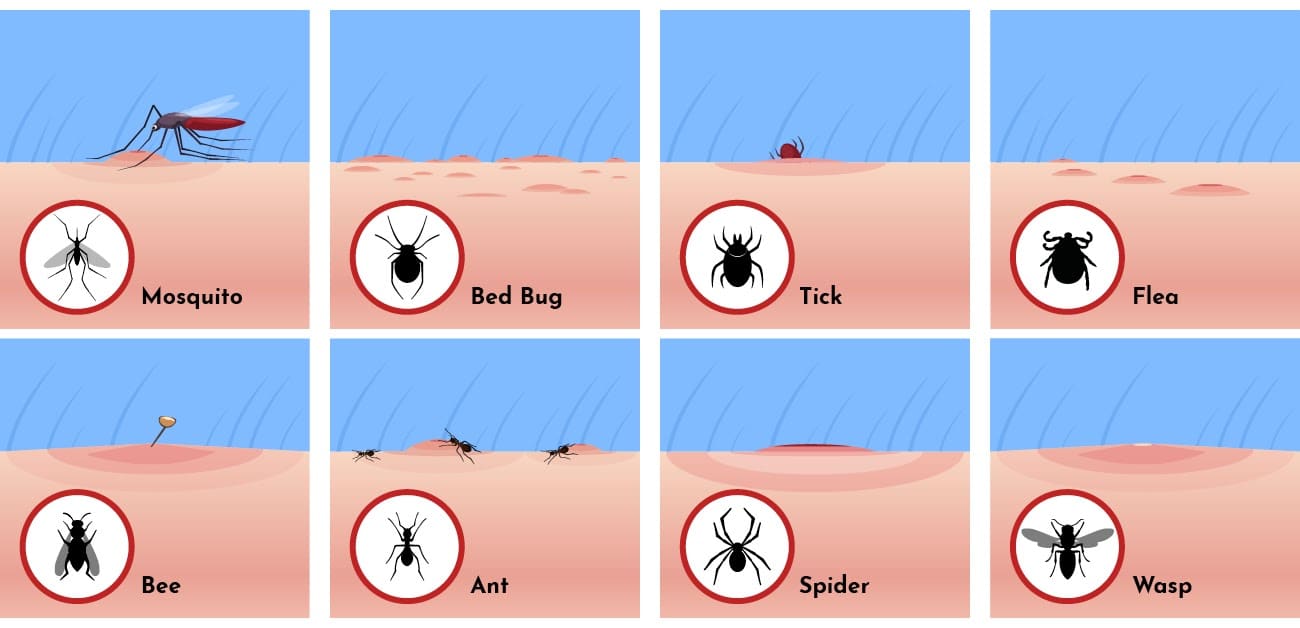Identifying Insect Bites: A Comprehensive Guide With Pictures
Identifying insect bites can be a crucial skill for anyone who spends time outdoors or has a garden. Understanding the various types of insect bites not only helps in managing symptoms but also in preventing potential allergic reactions and infections. In this article, we will delve deep into the different types of insect bites, provide pictures for better identification, and offer useful tips on how to treat and prevent them.
Insects are a vital part of our ecosystem, but they can also be a nuisance and, in some cases, pose health risks. Insect bites can range from harmless to potentially life-threatening, depending on the type of insect and the individual's reaction to the bite. Knowing how to identify insect bites can empower you to take the right actions quickly, ensuring your safety and well-being.
This article aims to serve as a comprehensive resource for identifying insect bites, complete with images and detailed descriptions. By the end of this guide, you will not only be able to recognize various insect bites but also understand the appropriate steps to take for treatment and prevention.
Table of Contents
- 1. Understanding Insect Bites
- 2. Common Types of Insect Bites
- 3. Identifying Insect Bites with Pictures
- 4. Treatment and Prevention Tips
- 5. When to Seek Medical Attention
- 6. Conclusion
1. Understanding Insect Bites
Insect bites occur when an insect punctures the skin to feed on blood or insert venom. The body's immune response to these bites can vary significantly among individuals, leading to different symptoms. Some may experience mild itching and redness, while others may suffer from severe allergic reactions.
Insects that bite can be classified into two main categories: those that feed on blood and those that inject venom. Understanding the difference can help you identify the type of bite you're dealing with.
Common insects that bite include mosquitoes, ticks, fleas, spiders, and ants. Each type of insect bite has distinct characteristics, and recognizing these can aid in determining the best course of action for treatment.
2. Common Types of Insect Bites
2.1 Mosquito Bites
Mosquito bites are among the most common insect bites. They typically appear as small, raised, red bumps on the skin. The itching sensation is caused by the saliva that the mosquito injects while feeding.
- Characteristics: Red, itchy bumps.
- Common areas: Arms, legs, and exposed skin.
- Potential risks: Can transmit diseases like malaria and dengue fever.
2.2 Spider Bites
Spider bites can vary in appearance depending on the type of spider. While most spider bites are harmless, some, like those from black widow or brown recluse spiders, can be serious.
- Characteristics: Redness, swelling, and pain, sometimes with a blister.
- Common areas: Legs and arms.
- Potential risks: Can lead to serious infections or systemic reactions.
2.3 Flea Bites
Flea bites usually occur in clusters and are characterized by small, red, itchy bumps. They often appear in groups of three or four.
- Characteristics: Small, red, itchy bumps.
- Common areas: Ankles and legs.
- Potential risks: Can cause allergic reactions and transmit diseases.
2.4 Tick Bites
Tick bites can be harder to detect since ticks often attach themselves without causing immediate discomfort. They can transmit serious diseases such as Lyme disease.
- Characteristics: Red spot with a dark center (the tick).
- Common areas: Areas with dense hair, such as the scalp or groin.
- Potential risks: Lyme disease and other tick-borne illnesses.
3. Identifying Insect Bites with Pictures
Visual identification is crucial for recognizing insect bites. Here are some images to help you identify common insect bites:
- Mosquito Bite: 
- Spider Bite: 
- Flea Bite: 
- Tick Bite: 
4. Treatment and Prevention Tips
Once you identify the type of insect bite, it's essential to know how to treat it effectively. Here are some general treatment and prevention tips:
- Clean the area with soap and water to prevent infection.
- Apply a cold compress to reduce swelling and itching.
- Use over-the-counter antihistamines or hydrocortisone cream for itching.
- For severe reactions, seek medical attention immediately.
5. When to Seek Medical Attention
If you experience any of the following symptoms after an insect bite, seek medical attention:
- Difficulty breathing or swallowing.
- Severe swelling or rash.
- Fever or chills.
- Persistent pain or worsening symptoms.
6. Conclusion
Identifying insect bites is an essential skill for anyone who enjoys the outdoors. By understanding the different types of insect bites and their characteristics, you can take appropriate actions to treat and prevent them. Remember to consult a healthcare professional if you experience severe symptoms or if you're unsure about the type of bite you've received.
We encourage you to share your thoughts in the comments below, and don’t hesitate to explore more articles on our site for additional information on health and safety.
Final Thoughts
We hope this guide on identifying insect bites has been informative and helpful. Stay safe and vigilant, and we look forward to seeing you back on our site for more engaging content!
Savings Account Interest Rates: Understanding And Maximizing Your Returns
What Is Mutton? A Comprehensive Guide To Understanding This Delicious Meat
Exploring The Influence Of Ian Rapoport On Twitter: A Deep Dive


